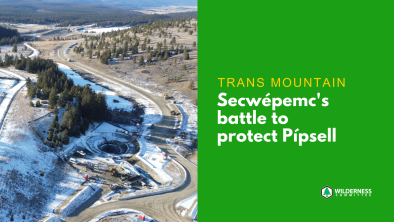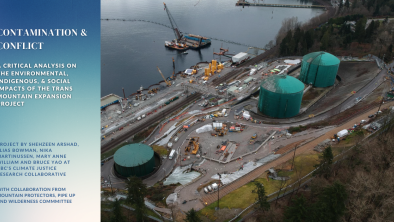Is push to export oil to China worth risk of catastrophic spill?
Monday, August 10, 2009
Edmonton Journal

A recent Canwest News report described how "China's energy buying spree is bypassing Canada's oilpatch." Depending on one's viewpoint, this could be something to lament or something to be relieved about.
According to the article, a primary reason for China's hesitancy has to do with "the lack of pipeline infrastructure to the West Coast that could facilitate the export of oilsands production to China and other countries in the Far East."
The article asserts there is "a tepid political climate at the federal level" in terms of supporting such infrastructure. Nevertheless, Enbridge Inc. is moving full speed ahead to convince British Columbians that embracing its Northern Gateway pipeline project is in everyone's best interests. With enormous financial backing, a phalanx of consultants, and a slicker than slick television advertising campaign, website, electronic newsletter and glossy coffee-table style brochures, Enbridge is counting on a sophisticated public-relations effort to swamp any opposition to Northern Gateway.
Art Sterritt, Coastal First Nations executive director, recently summed up the threat to aboriginal communities posed by oil tankers that would ship Alberta crude from the Enbridge pipeline to hydrocarbon-hungry markets abroad: "The minute there is tanker traffic, there is damage to a way of life."
The same could be said for non-aboriginal coastal communities.
This prompts the question: Is the benefit to Alberta of supplying China with oil worth the risk, even if it means increasing the chance of a catastrophic spill in B. C.?
In another Canwest article, "West Coast oilsands exports at record," it was insightful to read that Enbridge has been able to ratchet up its Northern Gateway project because "anonymous producers ponied up $100 million to obtain regulatory approvals." Parenthetically, one wonders who these mysterious backers of the pipeline might be. Unfortunately, Enbridge management won't reveal their identities.
It is amazing to witness the ongoing public discussion being held in the business media among Alberta oilsands interests about building pipelines to the B. C. coast as if British Columbians didn't exist.
The Enbridge pipeline from northern Alberta to Kitimat would put the marine environment of B. C.'s coast at serious risk. If the pipeline is constructed, condensate tankers and oil tankers at least as big as the Exxon Valdez would ply B. C.'s rocky northern coastline virtually daily, entering Douglas Channel within eyesight of where the 120-metre B. C. ferry Queen of the North struck Gil Island and sank in 2006.
The Enbridge pipeline would ship more than 500,000 barrels of crude oil per day and, twice a week, 350-metre-long supertankers would pass by the spot where the Queen of the North went down.
The federal government's joint review panel process for the Northern Gateway project is fatally flawed as the parameters for assessing risk illogically stop at the putative Kitimat terminal.
Beyond the terminal, the potential impacts of the Enbridge pipeline enter the realm of the unthinkable with regard to the greater marine environment. For instance, an Exxon Valdez-like spill would be devastating for B. C.'s marine bird populations and the environments they inhabit. In the immediate aftermath of the Exxon Valdez, it was estimated that several hundreds of thousands of marine birds were killed. Further, after two decades, a number of marine bird populations have not yet recovered in the areas affected by the Exxon Valdez disaster.
Raincoast Conservation has been working to fill basic knowledge gaps regarding marine bird distribution, density and seasonal shifts in community assemblages in the waters adjacent to B. C.'s central and north coast. Raincoast has documented more than 70 species and amassed nearly 20,000 sightings of more than 100,000 individual marine and other coastal birds. Raincoast scientists continue to seek to identify areas important for marine birds and examine the potential for conflict with increasing industrial activity, like oil tanker traffic.
The scope of the joint review panel should have been expanded to include risks from coastal tanker traffic to the marine environment; the pipeline and attendant tanker traffic cannot be compartmentalized as they are essentially one in the same, and to pretend otherwise makes a mockery of the process.
In response to the shortcomings in the regulatory approval process, as recently reported in the Kitimat Northern Sentinel, a call has emanated from many in the region for a full public inquiry on Northern Gateway. They rightly argue that the real issue is whether the project should go ahead at all, not simply how it will proceed.
Chris Genovali is executive director of Raincoast Conservation
© Copyright (c) The Edmonton Journal
http://www.edmontonjournal.com/business/push+export+China+worth+risk+ca…
According to the article, a primary reason for China's hesitancy has to do with "the lack of pipeline infrastructure to the West Coast that could facilitate the export of oilsands production to China and other countries in the Far East."
The article asserts there is "a tepid political climate at the federal level" in terms of supporting such infrastructure. Nevertheless, Enbridge Inc. is moving full speed ahead to convince British Columbians that embracing its Northern Gateway pipeline project is in everyone's best interests. With enormous financial backing, a phalanx of consultants, and a slicker than slick television advertising campaign, website, electronic newsletter and glossy coffee-table style brochures, Enbridge is counting on a sophisticated public-relations effort to swamp any opposition to Northern Gateway.
Art Sterritt, Coastal First Nations executive director, recently summed up the threat to aboriginal communities posed by oil tankers that would ship Alberta crude from the Enbridge pipeline to hydrocarbon-hungry markets abroad: "The minute there is tanker traffic, there is damage to a way of life."
The same could be said for non-aboriginal coastal communities.
This prompts the question: Is the benefit to Alberta of supplying China with oil worth the risk, even if it means increasing the chance of a catastrophic spill in B. C.?
In another Canwest article, "West Coast oilsands exports at record," it was insightful to read that Enbridge has been able to ratchet up its Northern Gateway project because "anonymous producers ponied up $100 million to obtain regulatory approvals." Parenthetically, one wonders who these mysterious backers of the pipeline might be. Unfortunately, Enbridge management won't reveal their identities.
It is amazing to witness the ongoing public discussion being held in the business media among Alberta oilsands interests about building pipelines to the B. C. coast as if British Columbians didn't exist.
The Enbridge pipeline from northern Alberta to Kitimat would put the marine environment of B. C.'s coast at serious risk. If the pipeline is constructed, condensate tankers and oil tankers at least as big as the Exxon Valdez would ply B. C.'s rocky northern coastline virtually daily, entering Douglas Channel within eyesight of where the 120-metre B. C. ferry Queen of the North struck Gil Island and sank in 2006.
The Enbridge pipeline would ship more than 500,000 barrels of crude oil per day and, twice a week, 350-metre-long supertankers would pass by the spot where the Queen of the North went down.
The federal government's joint review panel process for the Northern Gateway project is fatally flawed as the parameters for assessing risk illogically stop at the putative Kitimat terminal.
Beyond the terminal, the potential impacts of the Enbridge pipeline enter the realm of the unthinkable with regard to the greater marine environment. For instance, an Exxon Valdez-like spill would be devastating for B. C.'s marine bird populations and the environments they inhabit. In the immediate aftermath of the Exxon Valdez, it was estimated that several hundreds of thousands of marine birds were killed. Further, after two decades, a number of marine bird populations have not yet recovered in the areas affected by the Exxon Valdez disaster.
Raincoast Conservation has been working to fill basic knowledge gaps regarding marine bird distribution, density and seasonal shifts in community assemblages in the waters adjacent to B. C.'s central and north coast. Raincoast has documented more than 70 species and amassed nearly 20,000 sightings of more than 100,000 individual marine and other coastal birds. Raincoast scientists continue to seek to identify areas important for marine birds and examine the potential for conflict with increasing industrial activity, like oil tanker traffic.
The scope of the joint review panel should have been expanded to include risks from coastal tanker traffic to the marine environment; the pipeline and attendant tanker traffic cannot be compartmentalized as they are essentially one in the same, and to pretend otherwise makes a mockery of the process.
In response to the shortcomings in the regulatory approval process, as recently reported in the Kitimat Northern Sentinel, a call has emanated from many in the region for a full public inquiry on Northern Gateway. They rightly argue that the real issue is whether the project should go ahead at all, not simply how it will proceed.
Chris Genovali is executive director of Raincoast Conservation
© Copyright (c) The Edmonton Journal
http://www.edmontonjournal.com/business/push+export+China+worth+risk+ca…


